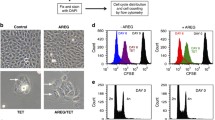Abstract
Involucrin is one of the precursor proteins of keratinocyte cornified envelope that is formed beneath the inner surface of the cell membrane during terminal differentiation. Although involucrin is specifically expressed in the upper squamous cells of the epidermis, the precise regulatory mechanism of involucrin gene expression remains unknown. Transcriptional enhancer factor 1 (TEF-1), which binds to SV40 enhancer, is a nuclear protein expressed in various types of cells including keratinocytes. Immunohistochemical study has revealed that TEF-1 protein is highly expressed on the basal cell layer of the epidermis. To examine the possible regulatory mechanism of involucrin gene expression by TEF-1 protein, we analysed involucrin promoter activity of the INV-CAT vector, which was constructed by connecting the 5′ upstream region of the involucrin gene (−801 bp upstream from the transcription start site and downstream including the untranslated first exon) to the chloramphenicol acetyltransferase (CAT) reporter gene. The INV-CAT vector was transfected to SV40-transformed human keratinocytes (SVHK). Cotransfection of the TEF-1 expression vector significantly repressed INV-CAT promoter activity in a dose-dependent manner. The repression was also observed by transfection of the GAL4-TEF-1 vector, which was constructed by replacement of the TEF-1 DNA binding domain by the GAL4 activator domain. This suggests that TEF-1-induced repression is due to interference/squelching of a limiting transcriptional intermediary factor that is essential for involucrin expression. Analysis of the deleted INV-CAT vector suggested that the region from −599 to −495 of the involucrin gene, which contains two possible TEF-1 binding sites, was critical for the repression of the involucrin gene by TEF-1. By gel retardation analysis, the specific DNA binding of SVHK cell nuclear extracts and the recombinant TEF-1 protein was confirmed. TEF-1-dependent repression of involucrin gene expression might explain the suprabasal involucrin expression in the epidermis.
Similar content being viewed by others
References
Goldsmith LA (1983) The epidermal cell periphery. In: Goldsmith LA (ed) Biochemistry and physiology of the skin. Oxford University Press, New York, pp 184–196
Hohl D (1990) Cornified envelope. Dermatologica 180: 201–211
Eckert RL, Yaffe MB, Crish JF et al (1993) Involucrin — structure and role in envelope assembly. J Invest Dermatol 100: 613–617
Iizuka H, Tahkahashi H (1993) Psoriasis, involucrin, and protein kinase C. Int J Dermatol 32: 333–338
Eckert RL, Green H (1986) Structure and evolution of the human involucrin gene. Cell 46: 583–589
Weinstraub H, Davis V, Tapscott S et al (1991) ThemyoD gene: nodal point during specification of muscle cell lineage. Science 251: 761–766
Bodner M, Castrillo JL, Thelli D et al (1988) The pituitary-specific transcription factor GHF-1 is a homeobox-containing protein. Cell 55: 505–518
Nelson C, Albert VR, Elsholtz HP et al (1988) Activation of cell-specific expression of rat growth hormone and prolactin genes by a common transcription factor. Science 239: 1400–1405
Crish JF, Howard JM, Zaim TM, Murthy S, Eckert RL (1993) Tissue-specific and differentiation-appropriate expression of the human involucrin gene in transgenic mice: an abnormal epidermal phenotype. Differentiation 53: 191–200
Takahashi H, Iizuka H (1993) Analysis of the 5′-upstream of human involucrin gene: activation by 12-O-tetradecanoylphorbol-13-acetate. J Invest Dermatol 100: 10–15
Davidson I, Xiao JH, Rosales R et al (1988) The HeLa cell protein TEF-1 binds specially and cooperatively to two SV40 enhancer motifs of unrelated sequence. Cell 54: 931–942
Xiao JH, Davidson I, Matthes H et al (1991) Cloning, expression, and transcriptional properties of the human enhancer factor TEF-1. Cell 65: 551–568
Ishiji T, Lace MJ, Pakkinen S et al (1992) Transcriptional enhancer factor (TEF)-1 and its cell-specific co-activator activate human papillomavirus-16 E6 and E7 oncogene transcription in keratinocytes and cervical carcinoma cells. EMBO J 11: 2271–2281
Hwang JJ, Chambon P, Davidson I (1993) Characterization of the transcription activation function and the DNA binding domain of transcriptional enhancer factor-1. EMBO J 12: 2337–2348
Steinberg ML, Defendi V (1983) Transformation and immortalization of human keratinocytes by SV40. J Invest Dermatol 81: 131S-136S
Felgner PL, Gadek TR, Holm M et al (1987) Lipofectin: a highly efficient, lipid-mediated DNA-transfected procedure. Proc Natl Acad Sci USA 84: 7413–7417
Neuman JR, Morency CA, Russian KD (1987) A novel rapid assay for chloramphenicol acetyltransferase gene expression. Biotechniques 5: 441
Maniatis T, Fritsch EH, Sambrook T (1989) Molecular cloning: a laboratory manual, 2nd edn. Cold Spring Harbor Laboratory, Cold Spring Harbor, pp 16.66–16.67
Carrol JM, Taichman LB (1992) Characterization of the human involucrin promoter using a transient β-galactosidase assay. J Cell Sci 103: 925–930
Carrol JM, Alberts KM, Galrick LA et al (1993) Tissue- and stratum-specific expression of the human involucrin promoter in transgenic mice. Proc Natl Acad Sci USA 90: 10270–10274
Blessing M, Zentgraft H, Jorcano JL (1987) Differentially expressed bovine cytokeratin genes. Analysis of gene linkage and evolutionary conservation of 5′-upstream sequences. EMBO J 6: 567–575
Tamai K, Sawamura D, Do HD et al (1993) The human 230-kD bullous pemphigoid antigen (BPAG1). Exon-intron organization and identification of regulatory tissue specific elements in the promoter region. J Clin Invest 92: 814–822
Snape AM, Jonas EA, Sargan TD (1990) KTF-1, a transcriptional activator of Xenopus embryonic keratin expression. Development 109: 157–165
Snape AM, Winning MR, Sargan TD (1991) Transcripitonal factor AP-2 is tissue-specific inXenopus and is closely related or identical to keratin transcriptional factor 1 (KTF-1). Development 113: 283–293
Leask AM, Rosenberg R, Vassar R et al (1990) Regulation of a human epidermal keratin gene: sequences and nuclear factor involved in keratinocytes-specific transcription. Genes Dev 4: 1985–1998
Leask AM, Byrne C, Fuchs E (1991) Transcriptional factor AP-2 and its role in epidermal-specific gene expression. Proc Natl Acad Sci USA 88: 7948–7985
Ishida-Yamamoto A, Iizuka H (1995) Differences in involucrin immunolabelling within cornified cell envelopes in normal and psoriatic epidermis. J Invest Dermatol 104: 391–395
Younus J, Gilchrest BA (1992) Modulation of mRNA levels during human keratinocyte differentiation. J Cell Physiol 152: 232–239
Author information
Authors and Affiliations
Rights and permissions
About this article
Cite this article
Takahashi, H., Kobayashi, H., Matsuo, S. et al. Repression of involucrin gene expression by transcriptional enhancer factor 1 (TEF-1). Arch Dermatol Res 287, 740–746 (1995). https://doi.org/10.1007/BF01105799
Received:
Issue Date:
DOI: https://doi.org/10.1007/BF01105799




